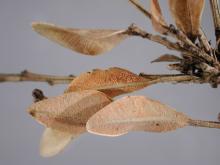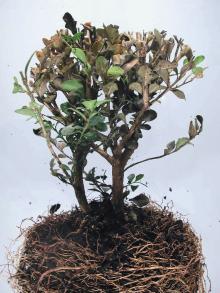See:
Boxwood (Buxus spp.) - Boxwood Blight
Cause Pseudonectria buxi (asexual: Volutella buxi) and P. foliicola, fungi that survive in affected branches and leaves. Boxwood is susceptible to infection when subjected to wounds or winter injury. Optimal temperature for infection and disease development is 68°F to 77°F when relative humidity is 85% or greater. Infection often occurs at the bases of small dead shoots, or in crotches where leaves have accumulated, or through pruning wounds. One-month-old leaves were much more susceptible than 1-year-old leaves.
Most common cultivars such as Green Velvet, Green Gem, Green Mountain and Chicagoland Green are susceptible. 'Pincushion' has exhibited less disease in inoculation tests and at nurseries in Ontario, Canada, but no cultivars are immune.
Symptoms Branches die back and leaves turn from green to light green-yellow and finally to shades of tan. Affected leaves turn up and lie close to the stem. Black streaks may be found on some petioles or on stems near petiole attachment. These symptoms are similar to winter injury, except that numerous, small, salmon-pink fungal spore-producing structures (sporodochia) appear on lower surfaces of affected leaves and branches.
Cultural control
- Prune out and burn dead branches.
- Remove dead leaves from crotches areas inside the canopy.
- Minimize wounding especially when new growth is present.
- Maintain good air circulation and drainage.
- Avoid high humidity (>85%) for long periods.
- Grow plants in well-drained media or soil with a pH between 6.8 and 7.5. Light shade of 20% can also reduce injury from summer and winter extremes.
Chemical control Spray fungicides in spring, before new growth starts, and again in late spring anytime wounded tissue may occur such as after pruning.
- Avelyo at 3 to 5 fl oz/100 gal water. Group 3 fungicide. 12-hr reentry.
- Banner MAXX at 2 to 4 fl oz/100 gal water. Group 3 fungicide. 12-hr reentry.
- Bordeaux. O
- Broadform at 4 to 6 fl oz/100 gal water. Group 7 + 11 fungicide. 12-hr reentry.
- Cleary's 3336 EG at 12 to 16 oz/100 gal water plus another fungicide from another fungicide group. Boxwood is NOT specifically mentioned on the label but may legally be used. Group 1 fungicide. 12-hr reentry.
- Concert II at 26 to 35 fl oz/100 gal water. Might leave a slight residue on leaves and/or slight plant growth regulation effect. For use in nurseries and some landscapes. Group 3 + M5 fungicide. 12-hr reentry.
- CuPRO 5000 at 1.5 to 5 lb/A but only up to 2 lb/A when new growth is present. 48-hr reentry.
- Daconil Weather Stik at 1.38 pints/100 gal water. Do not use with a surfactant. Can be used in the landscape and many other sites. Boxwood is not on the label but may legally be used. Test first on a small section before applying on the whole plant to evaluate possible phytotoxicity. Group M5 fungicide. 12-hr reentry.
- Dexter Max at 1 to 2.1 lb/100 gal water. Group M3 + 11 fungicide. 24-hr reentry.
- Mancozeb-based products. Group M3 fungicides. 24-hr reentry.
- Fore 80 WP at 1.5 lb/100 gal water plus a spreader-sticker.
- Protect DF at 1 to 2 lb/100 gal water plus 2 to 4 oz spreader-sticker.
- Phyton 27 at 1.5 to 2.5 fl oz/10 gal water. M1 fungicide. 48-hr reentry.
- ProStar 70 WG at 6 oz/100 gal water. Group 7 fungicide. 12-hr reentry.
- Rex Lime sulfur at 0.5 gal/100 gal water after leaves are cleaned up. 48-hr reentry. H O
Reference Yang, X., Castroagudín, V.L., Daughtrey, M.L., Loyd, A.L., Weiland, J.E., Shishkoff, N., Baysal-Gurel, F., Santamaria, L., Salgado-Salazar, C., LaMondia, J.A. and Crouch, J.A. 2021. A Diagnostic Guide for Volutella Blight Affecting Buxaceae. Plant Health Progress. 22:578-590. https://doi.org/10.1094/PHP-02-21-0052-DG



